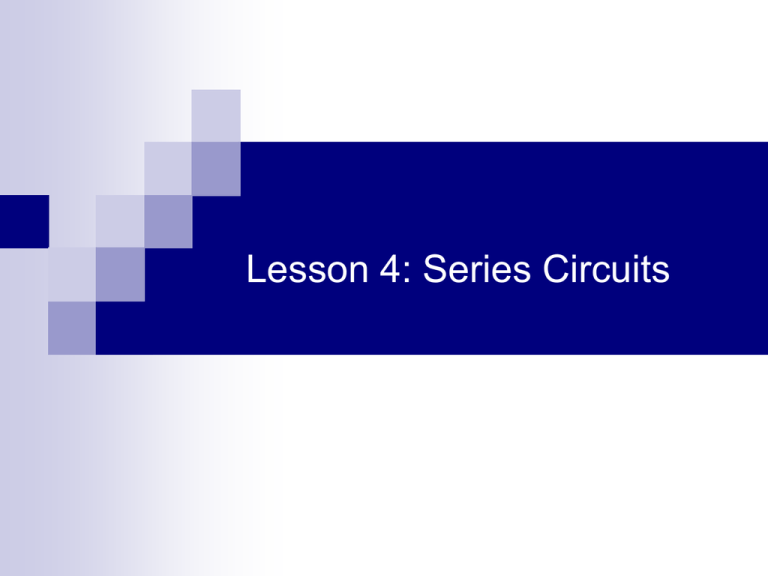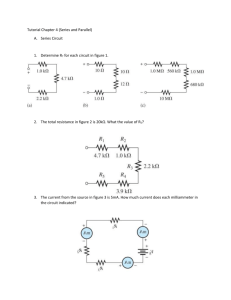Series Circuits
advertisement

Lesson 4: Series Circuits Learning Objectives Identify elements that are connected in series. State and apply KVL in analysis of a series circuit. Determine the net effect of series-aiding and seriesopposing voltage sources. Compute the power dissipated by each element and the total power in a series circuit. Compute voltage drops across resistors using the voltage divider formula. Learning Objectives Apply concept of voltage potential between two points to the use of subscripts and the location of the reference voltage. Analyze a series resistive circuit with the ground placed at various points SERIES RESISTORS Before the series connection is described, first recognize that every fixed resistor has only two terminals to connect in a configuration—it is therefore referred to as a two-terminal device. FIG. 5.4 Series connection of resistors. SERIES RESISTORS FIG. 5.6 Series connection of resistors. FIG. 5.7 Series connection of four resistors of the same value Series Circuits Two elements in a series Connected at a single point (node) No other current-carrying connections at this node The same current flows through series connected circuits. Series Circuits Normally Current will leave the positive terminal of a voltage source and move through the resistors Return to negative terminal of the source Current is the same everywhere in a series circuit Series Circuits Current is similar to water flowing through a pipe Current leaving the element must be the same as the current entering the element Current = water flow rate Pressure = potential difference = voltage Same current passes through every element of a series circuit Kirchhoff’s voltage law (1) Kirchhoff’s voltage law (KVL) states that the algebraic sum of all voltages around a closed path (or loop) is zero. M vm 0 Mathematically, KVL implies m 1 ET - V1 - V2 - V3 - ∙∙∙ - Vn = 0 Kirchhoff’s voltage law (2) Another way of stating KVL is: Summation of voltage rises is equal to the summation of voltage drops around a closed loop V1 + V2 + V3 + ∙∙∙ + Vn = ET being ET= E1+E2+E3+…+En Kirchhoff’s Voltage Law (KVL) (3) A closed loop is any path that: Originates at a point Travels around a circuit Returns to the original point without retracing any segments V 0 ( c lo s e d lo o p ) Kirchhoff’s Voltage Law (4) Summation of voltage rises is equal to the summation of voltage drops around a closed loop E r is e s V drops E1 + E2 = v1 + v2 + v3 Example Problem 1 Determine the unknown voltages in the network below: Example Problem 2 Use Kirchhoff’s Voltage Law to determine the magnitude and polarity of the unknown voltage ES in the circuit below: Resistors in Series Most complicated circuits can be simplified For a series circuit V1 + V2 + V3 = E IR1 + IR2 + IR3 = E I(R1 + R2 + R3 )= E I(R1 + R2 + R3 )= IRtotal (Note: I’s cancel) Two resistors in series Two resistors in series can be replaced by an equivalent resistance Req. Req R1 R2 N resistors in series The equivalent resistance Req of any number of resistors in series is the sum of the individual resistances. Req R1 R2 N RN Rn n 1 The Voltage Divider Rule Voltage applied to a series circuit: Voltage drop across any series resistor is proportional to the magnitude of the resistor. The voltage divider rule allows us to calculate the voltage across any series resistance in a single step, without first calculating the current. VOLTAGE DIVISION IN A SERIES CIRCUIT Voltage Divider Rule (VDR) The voltage divider rule states that the voltage across a resistor in a series circuit is equal to the value of that resistor times the total applied voltage divided by the total resistance of the series configuration. The Voltage Divider Rule Voltage applied to a series circuit: Voltage drop across each resistor may be determined by the proportion of its resistance to the total resistance: I Total E RTotal Total Current in the Circuit Rx Vx I Total Rx Vx E RTotal Voltage Divider Rule Application If a single resistor is very large (~100x) compared to the other series resistors, the voltage across that resistor will be the source voltage Voltage across the small resistors will be essentially zero R2 V2 E R1 R2 R3 R4 600 120V 2 600 3 1 119V Voltage Divider Application: Simple Power Supply = 75 Ω = 25 Ω R2 Vab E R1 R2 25 12 3V 100 Resistors in Series Example Problem 3 For the circuit below (with Rtot =800Ω), determine: Direction and magnitude of current Voltage drop across each resistor Value of the unknown resistance Power in a Series Circuit Power dissipated by each resistor is determined by the power formulas: P = VI = V2/R = I2R Power in a Series Circuit Since energy must be conserved, power delivered by voltage source is equal to total power dissipated by resistors PT = P1 + P2 + P3 + ∙∙∙ + Pn Example Problem 4 For the circuit below, determine: Power dissipated by each resistor and total power dissipated by the circuit. Verify that the summation of the power dissipated by each resistor equals the total power delivered by the voltage source. Voltage Sources in Series In a circuit with more than one source in series Sources can be replaced by a single source having a value that is the sum or difference of the individual sources Polarities must be taken into account Voltage Sources in Series Resultant source Sum of the rises in one direction minus the sum of the voltages in the opposite direction Simplifying Sources Interchanging Series Components Order of series components May be changed without affecting operation of circuit Sources may be interchanged, but their polarities can not be reversed After circuits have been redrawn, it may become easier to visualize circuit operation Interchanging Series Components Example Problem 5 Redraw the circuit below, showing a single voltage source and single resistor. Solve for the current in the circuit. Example Problem 6 Find the output voltage Vab across the R2 resistor. = 50 Ω = 30 Ω = 20 Ω Circuit Ground Ground Point of reference or a common point in a circuit for making measurements Chassis ground: Common point of circuit is often the metal chassis of the piece of equipment Circuit Ground Earth ground Physically connected to the earth by a metal pipe or rod Chassis ground Often connected to Earth Ground If a fault occurs within a circuit, the current is redirected to the earth NOTATION Voltage Sources and Ground FIG. 5.46 Three ways to sketch the same series dc circuit. NOTATION Voltage Sources and Ground FIG. 5.47 Replacing the special notation for a dc voltage source with the standard symbol. FIG. 5.48 Replacing the notation for a negative dc supply with the standard notation. NOTATION Double-Subscript Notation The fact that voltage is an across variable and exists between two points has resulted in a double-subscript notation that defines the first subscript as the higher potential. FIG. 5.50 Defining the sign for doublesubscript notation. NOTATION Double-Subscript Notation The double-subscript notation Vab specifies point a as the higher potential. If this is not the case, a negative sign must be associated with the magnitude of Vab. In other words, the voltage Vab is the voltage at point a with respect to (w.r.t.) point b. NOTATION General Comments A particularly useful relationship can now be established that has extensive applications in the analysis of electronic circuits. For the above notational standards, the following relationship exists: NOTATION General Comments FIG. 5.52 Example 5.21. FIG. 5.53 Example 5.22. NOTATION General Comments FIG. 5.54 Example 5.23. FIG. 5.55 The impact of positive and negative voltages on the total voltage drop. NOTATION Single-Subscript Notation If point b of the notation Vab is specified as ground potential (zero volts), then a singlesubscript notation can be used that provides the voltage at a point with respect to ground. FIG. 5.51 Defining the use of singlesubscript notation for voltage levels. Single Subscripts If voltages at various points in a circuit are known with respect to ground, then the voltage between points is easily determined Vab = Va – Vb Example Problem 4 Find Va, Vb, Vc, Vd








